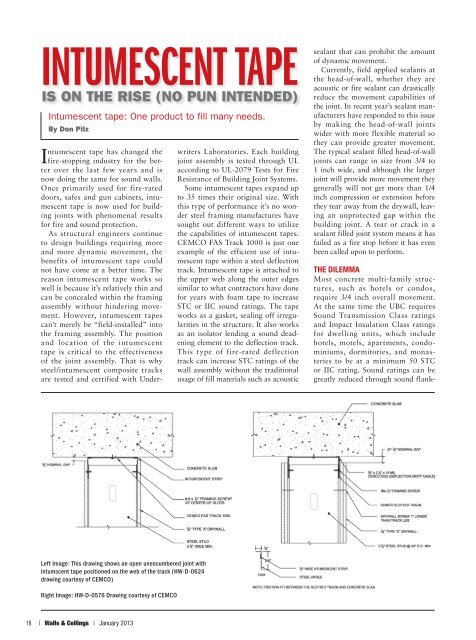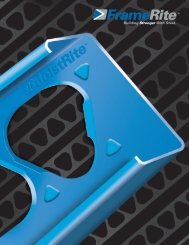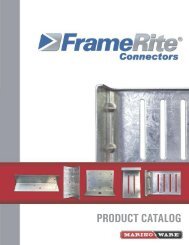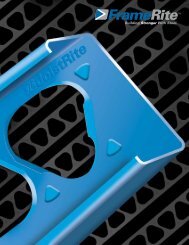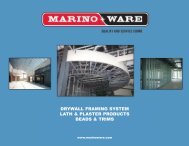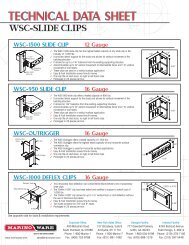Intumescent tape - Marino\WARE
Intumescent tape - Marino\WARE
Intumescent tape - Marino\WARE
Create successful ePaper yourself
Turn your PDF publications into a flip-book with our unique Google optimized e-Paper software.
<strong>Intumescent</strong> Tape<br />
Is on the rise (No Pun Intended)<br />
<strong>Intumescent</strong> <strong>tape</strong>: One product to fill many needs.<br />
By Don Pilz<br />
<strong>Intumescent</strong> <strong>tape</strong> has changed the<br />
fire-stopping industry for the better<br />
over the last few years and is<br />
now doing the same for sound walls.<br />
Once primarily used for fire-rated<br />
doors, safes and gun cabinets, intumescent<br />
<strong>tape</strong> is now used for building<br />
joints with phenomenal results<br />
for fire and sound protection.<br />
As structural engineers continue<br />
to design buildings requiring more<br />
and more dynamic movement, the<br />
benefits of intumescent <strong>tape</strong> could<br />
not have come at a better time. The<br />
reason intumescent <strong>tape</strong> works so<br />
well is because it’s relatively thin and<br />
can be concealed within the framing<br />
assembly without hindering movement.<br />
However, intumescent <strong>tape</strong>s<br />
can’t merely be “field-installed” into<br />
the framing assembly. The position<br />
and location of the intumescent<br />
<strong>tape</strong> is critical to the effectiveness<br />
of the joint assembly. That is why<br />
steel/intumescent composite tracks<br />
are tested and certified with Underwriters<br />
Laboratories. Each building<br />
joint assembly is tested through UL<br />
according to UL-2079 Tests for Fire<br />
Resistance of Building Joint Systems.<br />
Some intumescent <strong>tape</strong>s expand up<br />
to 35 times their original size. With<br />
this type of performance it’s no wonder<br />
steel framing manufactures have<br />
sought out different ways to utilize<br />
the capabilities of intumescent <strong>tape</strong>s.<br />
CEMCO FAS Track 1000 is just one<br />
example of the efficient use of intumescent<br />
<strong>tape</strong> within a steel deflection<br />
track. <strong>Intumescent</strong> <strong>tape</strong> is attached to<br />
the upper web along the outer edges<br />
similar to what contractors have done<br />
for years with foam <strong>tape</strong> to increase<br />
STC or IIC sound ratings. The <strong>tape</strong><br />
works as a gasket, sealing off irregularities<br />
in the structure. It also works<br />
as an isolator lending a sound deadening<br />
element to the deflection track.<br />
This type of fire-rated deflection<br />
track can increase STC ratings of the<br />
wall assembly without the traditional<br />
usage of fill materials such as acoustic<br />
sealant that can prohibit the amount<br />
of dynamic movement.<br />
Currently, field applied sealants at<br />
the head-of-wall, whether they are<br />
acoustic or fire sealant can drastically<br />
reduce the movement capabilities of<br />
the joint. In recent year’s sealant manufacturers<br />
have responded to this issue<br />
by making the head-of-wall joints<br />
wider with more flexible material so<br />
they can provide greater movement.<br />
The typical sealant filled head-of-wall<br />
joints can range in size from 3/4 to<br />
1 inch wide, and although the larger<br />
joint will provide more movement they<br />
generally will not get more than 1/4<br />
inch compression or extension before<br />
they tear away from the drywall, leaving<br />
an unprotected gap within the<br />
building joint. A tear or crack in a<br />
sealant filled joint system means it has<br />
failed as a fire stop before it has even<br />
been called upon to perform.<br />
THE DILEMMA<br />
Most concrete multi-family structures,<br />
such as hotels or condos,<br />
require 3/4 inch overall movement.<br />
At the same time the UBC requires<br />
Sound Transmission Class ratings<br />
and Impact Insulation Class ratings<br />
for dwelling units, which include<br />
hotels, motels, apartments, condominiums,<br />
dormitories, and monasteries<br />
to be at a minimum 50 STC<br />
or IIC rating. Sound ratings can be<br />
greatly reduced through sound flank-<br />
Left Image: This drawing shows an open unencumbered joint with<br />
intumscent <strong>tape</strong> positioned on the web of the track (HW-D-0624<br />
drawing courtesy of CEMCO)<br />
Right Image: HW-D-0576 Drawing courtesy of CEMCO<br />
18 | Walls & Ceilings | January 2013
BlazeSeal intumescent <strong>tape</strong>. (Courtesy of Rectorseal<br />
Test Lab)<br />
After 3/4 inch movement test, according to<br />
UL-2079, the acoustic sealant separates from<br />
drywall (Photo courtesy of Rectorseal Test Lab)<br />
After burn test, intumescent <strong>tape</strong> expands to<br />
completely fill in head-of-wall gap (Photo courtesy<br />
of Rectorseal Test Lab)<br />
ing paths. To reduce flanking paths,<br />
drywall should be sealed tight to the<br />
framing member around the perimeter.<br />
However, in traditional metal<br />
stud framed walls, framing screws<br />
that attach the stud to the track cause<br />
the drywall to hump up around the<br />
framing screw that provides a flanking<br />
path and increases sound transmission.<br />
Sound ratings can also be<br />
reduced in metal stud framing at the<br />
hard connection between the metal<br />
track and the floor or ceiling. For<br />
this reason, resilient partition isolation<br />
pads, acoustic sealant or foam<br />
<strong>tape</strong>s are sometimes utilized between<br />
the track and the ceiling or floor to<br />
reduce the potential sound loss due<br />
to flanking paths. But none of these<br />
sound aids provide fire protection if<br />
movement is required.<br />
What’s the contractor to do? On one<br />
hand, you have to provide an average<br />
of 3/4 inch overall movement for the<br />
building structure. On the other hand,<br />
you are required to provide applicable<br />
sound protection for dwelling units.<br />
Traditionally sound protection and fire<br />
protection do not work hand in hand<br />
when movement is involved.<br />
Making matters worse, contractors<br />
are bidding projects in a very competitive<br />
environment these days and in the<br />
past the traditional means and methods<br />
of a sealant filled head-of-wall<br />
joints were not watched very closely<br />
by the inspectors. So head-of-wall fire<br />
rated joints could be done relatively<br />
inexpensively by installing smaller<br />
width joints of 1/4 to 1/2 inch which<br />
will save material and labor costs rather<br />
than what is actually called out on<br />
the UL report at 3/4 to 1 inch. When<br />
you take into consideration the overall<br />
movement is based on the width of the<br />
joint and the percentage of the compression<br />
or extension listed on the UL<br />
report (typically listed at 18 to 25 percent)<br />
it is clear that making the joint<br />
smaller will only limit the amount of<br />
movement causing the joint to underperform.<br />
Most buildings are designed<br />
with a certain movement criteria. Certain<br />
walls within all structures are<br />
also designed to be fire-rated to enable<br />
safe egress hence the requirement for<br />
fire-rated walls with dynamic movement.<br />
A fire-rated joint that underperforms<br />
may not sound like a big deal<br />
during construction but if by underperforming<br />
the joint splits open and<br />
allows smoke to pass through the wall<br />
it can put lives at risk.<br />
SOLUTION<br />
Find out the movement requirement<br />
of the building structure and find a<br />
joint system that will provide it. If the<br />
UL report requires a 1-inch joint filled<br />
with a particular type of fire sealant<br />
then install it accordingly. If acoustic<br />
or fire sealant will not provide enough<br />
movement find something that will.<br />
There are deflection tracks with factory<br />
applied intumescent <strong>tape</strong>s, such<br />
as CEMCO FAS Track 1000, that will<br />
provide fire, smoke, and sound protection.<br />
This product is certified through<br />
UL according to UL-2079 and can<br />
meet greater deflection requirements<br />
with no fatigue splitting or cracking.<br />
But what if the project is already<br />
underway and the top track is already<br />
installed when you, the contractor<br />
find out the movement requirement is<br />
greater than what is achievable with<br />
fire sealant? It’s a little too late to<br />
switch out the installed deflection<br />
track for one with a factory applied<br />
intumescent <strong>tape</strong>. There is a solution.<br />
CEMCO DDA (Deflection Drift<br />
Angle) is a light gauge composite steel<br />
angle with intumescent <strong>tape</strong> along the<br />
inside leg which can be tapped into<br />
place over the leg of the installed top<br />
track. There are no mechanical fasteners<br />
required for installation. The<br />
3/4-inch horizontal leg of the product<br />
is friction fit between the web of the<br />
track and the overhead structure. This<br />
allows the wall assembly to move vertically<br />
and laterally without compromising<br />
the fire stop material. This type of<br />
fire-stopping product has other advantages;<br />
provides a universal fit for any<br />
wall width, gauge, height, whether the<br />
wall is standard, shaft wall, radius, or<br />
raked. It can go over either slotted or<br />
deep leg deflection track and finally it<br />
can provide up to 1¾-inch unencumbered<br />
joint protection.<br />
CONCLUSION<br />
Do your research when selecting<br />
head-of-wall fire protection. Make<br />
sure the manufactures joint system<br />
has been tested according to UL-2079<br />
“Tests for Fire Resistance of Building<br />
Joint Systems” and can provide<br />
the movement the building structure<br />
requires. If you decide to go with a<br />
steel/intumescent deflection track,<br />
make sure it has been sound tested<br />
and can meet the required STC rating.<br />
Finally, field installations can be very<br />
difficult make sure the joint system<br />
is being constructed as intended and<br />
described in the UL report. Underperforming<br />
joints are unacceptable, especially<br />
in multi-family dwellings. W&C<br />
After 23 years in the construction<br />
industry as a foreman<br />
and building envelope consultant,<br />
Don Pilz is now the R&D<br />
Manager for CEMCO, assisting consultants<br />
and contractors with detailing needs. He<br />
can be reached at dpilz@cemcosteel.com.<br />
January 2013 | www.wconline.com |<br />
19


